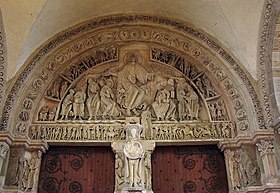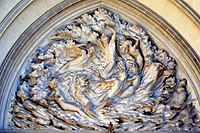Tympanum (architecture)

A tympanum (pl.: tympana; from Greek and Latin words meaning "drum") is the semi-circular or triangular decorative wall surface over an entrance, door or window, which is bounded by a lintel and an arch.[1] It often contains pedimental sculpture or other imagery or ornaments.[2] Many architectural styles include this element.[3]
Alternatively, the tympanum may hold an inscription, or in modern times, a clock face.
Tympanums in Antiquity and the Early Middle Ages
[edit]Tympanums are by definition inscriptions enclosed by a pediment,[4] however the evolution of tympanums gives them more specific implications. Pediments first emerged in classical Greece 700-480 BCE, with early examples such as the pantheon remaining famous to this day.[5] Pediments spread across the Hellenistic world with the rest of classical architecture. Inscriptions at the time were sometimes blank but often contained statues of the gods and representations of geographic features,[6] there are uncountable stories and messages in these inscriptions however the symbolism remained closely related to the philosophy and democracy associated with classical Greek city states. These themes continued when the Romans spread the style further into Europe, picking up an aspect of authoritarian symbolism in provinces captured by conquest.[5] Originally serving as the end of a gabled roof, in later imperial Rome the form was adjusted. Pediments started being placed above any doorway and curved instead of triangle shapes were introduced, ignoring structural value and instead using the now abstracted form purely for decoration.[7]
After the collapse of the Roman empire, regions with significant classical architecture quickly adopted and transformed the features. In France examples such as the Baptistry of St. Jean at Poitiers created in the 6th through 7th century CE defined Merovingian architecture. The form became abstracted in this period, replacing sculptures with geometric engravings and mosaics, and using small alternating curved and triangular pediments above windows on churches such as St. Generoux from the 9th or 10th century. This transformation continued throughout the later parts of the early Middle Ages, gradually shifting into the large circular stained glass windows of the gothic era known as rose windows.[7]
Classical pediments more closely transformed into rose windows than tympanums, and when pedimental shapes reappeared over gothic and Romanesque portals, inspiration can be traced in other directions. According to the Gospel of Luke, above Jesus on the cross was written "this is the king of jews" to mock his powerlessness. This inspired buildings as early as the arch of Constantine and old Saint Peters basilica which featured an engraving a Christ with a poem inscribed in second person perspective, an essential feature of later tympanum inscriptions. Early reliquaries and pilgrimage churches employed this convention, such as the Shrine of Saint Martin at Tours which in 558 installed engravings of the life of Christ and the churches patron saint (Saint Martin). These engravings situated directly above the main entrances had poems inscribed directing visitors on how they should feel entering the church. This was quickly replicated in Carolingian era churches such as the abbey of Saint Gall in Switzerland, completing the decorative style of the tympanum.[8]
Romanesque tympanums
[edit]The Romanesque era (1000–1200) saw massive change in church architecture. Pilgrimage required churches to rethink layouts and symbolism and the ever-rising Benedictine order changed rules on how churches should operate and appear. Architecturally the Romanesque era saw an increased appreciation for classical forms, coupled with an increase in church construction related to several factors including political turmoil and as thanks to god for not ending the world in the year 1000.[8] Tympanums are one of the most prominent features of Romanesque architecture, building on the French legacy of architectural innovation while also appearing on churches across Europe.
The tympanum above the west portal of the Sainte-Foy church in Conques is possibly the most famous tympanum; carved in the early 1100s it is emblematic of the style, purpose and culture of Romanesque tympanums. This tympanum depicts the last judgement, which was the subject of a large portion of tympanums, however, the Conques tympanum is far more detailed in its figures and scenes in a way reminiscent of Roman reliefs. This work was meant to be horrifying to the people who passed under it, on the right demons torture the souls of the damned, sinners are fed to grotesque monsters, and people are crammed into small spaces as they await their judgment. Contrasting this is Christ in the middle and the saved souls on the left, serving as a reminder for pilgrims of why they made their journey.[9] The imagery on this tympanum is primarily meant to remind the viewer of the power of gods judgement, part of many ways that tympanums through the era mentally prepare pilgrims for the experience of the church. There are many more subtle messages however, such as encouraging donations through depicting a miser character being damned, and even making comments about politics by showing Charlemagne bowing his head.[8]
Another example from France, the Coucy Doujon tympanum was carved between 1225 and 1230 and is evidence that tympanums were used in secular settings as well. The large tympanum was positioned above the door to the largest tower, as a way to tell anyone entering the building a message. The message for this particular tympanum is relatively unknown, featuring a figure likely from Coucy family history fighting a lion. Lions had many symbolic meanings in the Romanesque era and this one is likely a reference to a king or an event from the crusades. Despite the secular theme, it has a very similar style, form, and purpose to the many tympanums on nearby churches. Retaining the shape and inscription and showing a large central character with classically inspired detail, movement and emotion.[9]
Gallery
[edit]-
Baroque tympanum in the Queen's Bedroom in the Louvre Palace, Paris, by Michel Anguier and Pietro Sasso, with a painting of Judith and Holophernes, by Giovanni Francesco Romanelli, 1655[10]
-
Ex Nihilo (Out of Nothing) by Frederick Hart, tympanum over center doors, Washington National Cathedral, US
-
Tympanum of Kumari-ghar at Basantapur Durbar Square, Kathmandu
-
The three tympana on the main façade of Notre-Dame de Paris, France
-
Sculpted tympanum in Stralsund, Germany
-
Adoration of the Magi on a tympanum on Saint-Thiébaut Church, Thann, France
-
Religious scene in a tympanum, Church San Lorenzo, Vicenza, Italy
-
Scenes of the lives of Saint Peter and Mary, St Peter's, Vitoria-Gasteiz, Spain
-
High-relief bronze tympanum of Writing, Thomas Jefferson Building, Washington, D.C., US
-
Tympanum (showing the tree of life) and archivolt at Church of St Mary and St David, Kilpeck, Herefordshire, England
-
Tympanum showing Christ in Majesty with four attendant angels, Rowlestone, Herefordshire, England
-
Tympanum of the Manila Cathedral in Intramuros, Philippines
-
Tympanum of the church of the Sacred Heart, Templemore, Ireland
See also
[edit]- Lunette: semi-circular tympanum
- Church architecture
- Gable
- Pediment
- Portal
Citations
[edit]- ^ "Glossary - Tympanum". Architecture of the Indian Subcontinent. Archived from the original on 2012-03-06. Retrieved 2007-06-28.
- ^ "Glossary of Medieval Art and Architecture - tympanum". University of Pittsburgh. Archived from the original on 2018-01-16. Retrieved 2007-06-23.
- ^ "Illustrated Architecture Dictionary - Tympanum". www.buffaloah.com. Archived from the original on 2014-06-22. Retrieved 2014-04-12.
- ^ Tympanum. Vol. 1. Oxford University Press. 2003. doi:10.1093/gao/9781884446054.article.t086753.
- ^ a b Adamopoulou, Areti (2020-02-24), "Simultaneous Equations", Making Art History in Europe After 1945, New York, NY: Routledge, pp. 149–166, doi:10.4324/9781351187596-10, ISBN 978-1-351-18759-6
- ^ "Series: The Parthenon Sculptures". The Trustees of the British Museum. Retrieved 2024-10-30.
- ^ a b Holland, Leicester Bodine (1921). "Transformations of the Classic Pediment in Romanesque Architecture". American Journal of Archaeology. 25 (1): 55–74. doi:10.2307/497889. ISSN 0002-9114.
- ^ a b c Kendall, Calvin (1998-12-31). The Allegory of the Church. doi:10.3138/9781442680487.
- ^ a b Ambrose, Kirk (January 2011). "Attunement to the Damned of the Conques Tympanum". Gesta. 50 (1): 1–17. doi:10.2307/41550546. ISSN 0016-920X.
- ^ Bresc-Bautier, Geneviève (2008). The Louvre, a Tale of a Palace. Musée du Louvre Éditions. p. 56. ISBN 978-2-7572-0177-0.

![Baroque tympanum in the Queen's Bedroom in the Louvre Palace, Paris, by Michel Anguier and Pietro Sasso, with a painting of Judith and Holophernes, by Giovanni Francesco Romanelli, 1655[10]](http://upload.wikimedia.org/wikipedia/commons/thumb/2/26/Ceilings_of_the_appartements_d%27%C3%A9t%C3%A9_de_la_reine_Anne_d%27Autriche_%28449%29_%28tympanum_cropped%29.jpg/200px-Ceilings_of_the_appartements_d%27%C3%A9t%C3%A9_de_la_reine_Anne_d%27Autriche_%28449%29_%28tympanum_cropped%29.jpg)













